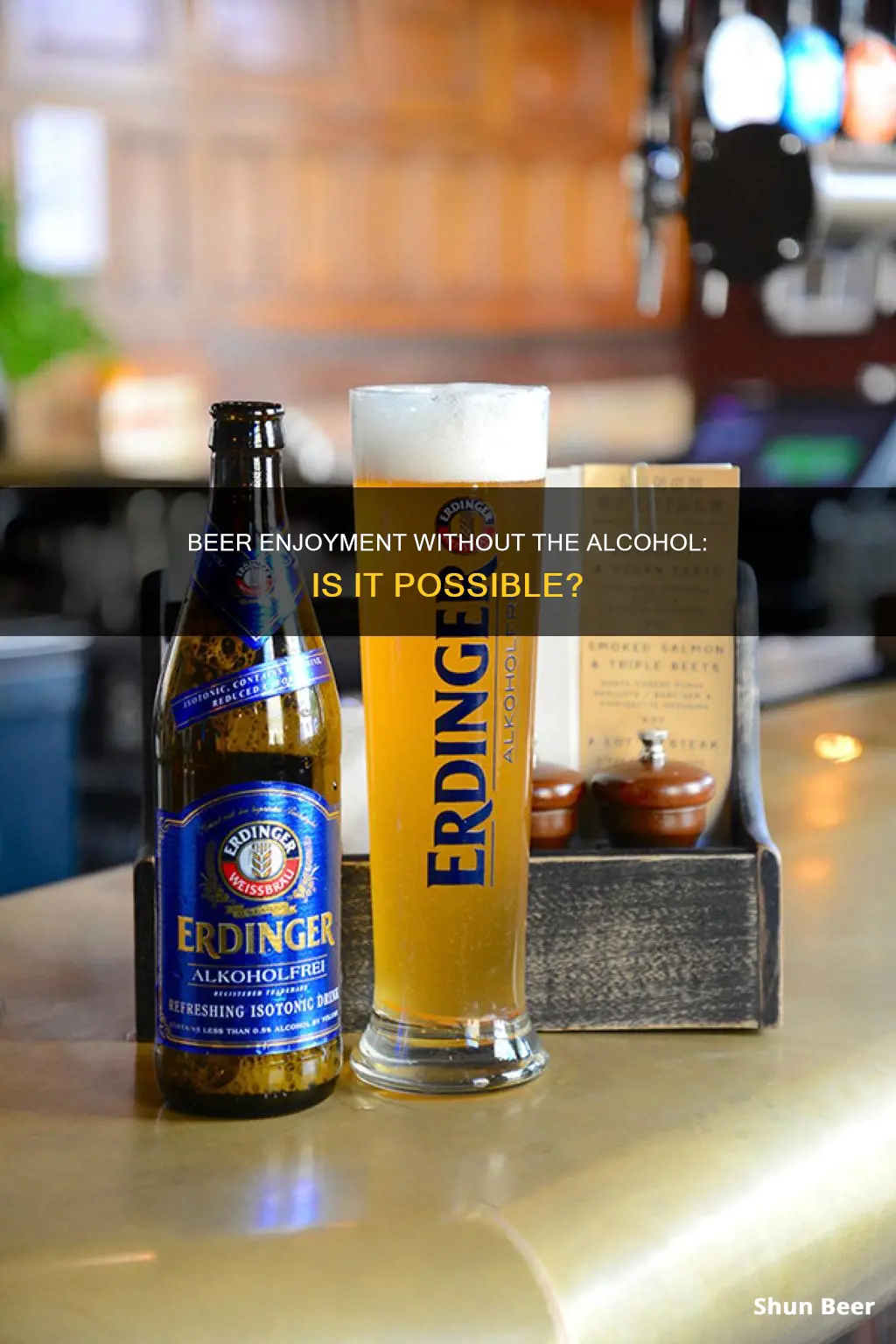
It's not uncommon to dislike beer, but that doesn't mean you dislike all alcohol. Beer is incredibly diverse, with a wide range of flavours, textures, and tastes. It's an acquired taste, and it may just be that you haven't found the right one for your palate yet. There are many reasons why someone might not like beer, from its bitter taste to its fizziness, or even an allergy to common beer ingredients. However, with so many varieties to choose from, it's worth exploring different options to find one that suits your taste.
| Characteristics | Values |
|---|---|
| Beer type | Belgian-style white ale, Chocolate stout, Wheat beer, Lager, Ale, Gose, Porter, etc. |
| Taste | Sweet, fruity, tart, refreshing, bitter, dry, creamy, etc. |
| Beer allergies | Common allergies to beer ingredients like barley, wheat, hops, or yeast |
| Carbonation | Some people dislike the prickly, burning sensation caused by carbonation |
| Aroma | Some people are sensitive to the aromatic compounds in beer |
| Genes | 'Supertasters' are more sensitive to bitter compounds due to a variant in the TAS2R38 taste receptor gene |
What You'll Learn

Beer is an acquired taste
Beer is often considered an acquired taste. The complex blend of bitterness, fizz, and a multitude of flavour profiles can be off-putting to the uninitiated palate. However, like coffee or spicy food, with exposure and experience, one can learn to appreciate and even savour the unique taste of beer.
The bitterness of beer is due to the presence of isohumulone, a chemical compound derived from hops, the pinecone-like flowers that form the backbone of beer. The higher the concentration of isohumulone, the more bitter the beer will taste. Starting with lower concentrations of isohumulone and gradually working your way up can make all the difference in acquiring a taste for beer.
Additionally, the alcohol content of beer also plays a role in its flavour profile. As the alcohol content rises, certain flavours can be intensified, and a warming sensation can be added to the drink. The higher alcohol content in some beers can introduce stronger, more potent flavours that may seem a bit much for those who are not used to it.
The diversity of beer flavours is also a factor in why it is considered an acquired taste. Beer offers a dizzying variety of flavours, from crisp, light lagers to dark, malty stouts, and intensely sour lambics to hoppy IPAs. Each beer is a unique blend of flavours, and with such a wide range of options, it can be challenging to know where to start.
Acquiring a taste for beer can be compared to learning a new language; it takes time, practice, and patience. It involves training your palate to understand and appreciate the complex symphony of flavours that beer brings to the table. However, once you get a hang of it, a world of delicious discovery awaits!
Beer Drinking: Dehydrating Effects and What You Need to Know
You may want to see also

Beer allergies are common
While true beer allergies are rare, it is common to have an intolerance to one of beer's many ingredients. This could be a food sensitivity or an alcohol intolerance.
Symptoms
If you are allergic to beer, you may experience symptoms such as:
- Abdominal pain and bloating
- Tightness of the chest
- Hives
- Wheezing
- Chest pain
These symptoms can be mild or severe and usually happen within a couple of hours. However, allergic reactions that involve hives, wheezing, and chest pain may occur almost immediately and are considered severe and potentially life-threatening.
If you have a beer intolerance, you may experience a combination of symptoms such as:
- Hives
- Nausea or vomiting
- Diarrhea
- Sneezing
- Wheezing
- Abdominal pain
Diagnosis
The best way to determine if you have a beer allergy is to visit an allergist and get an allergy test. One of the easiest ways to diagnose allergies is through a skin prick test, which takes about 15 minutes. If a skin prick test cannot be used, other methods such as an elimination diet or provocation test can be considered.
Treatment
If you are allergic to beer, the best treatment is avoidance. While most beer allergy symptoms are not life-threatening, it is important to stay away from the specific ingredients that trigger your allergy.
Beer and Injections: What's Safe to Drink?
You may want to see also

Try different types of beer
If you don't like beer but want to, trying different types is a great way to start your journey. Beer is a diverse universe of flavours, textures, and tastes. There are many different styles, from the puckering charm of sours to the dark depth of porters and the creamy richness of stouts.
If you're not a fan of the bitter taste of beer, you could try a Belgian-style white ale. These wheat beers are minimally bitter and taste a little like fruit, bread, and vanilla. Blue Moon Belgian White is a popular choice, with its citrusy aroma and flavour, and creamy mouthfeel.
If you're after something a little darker, you could try a stout. Saugatuck Neapolitan Milk Stout tastes like Neapolitan ice cream but in a smooth and light way. Or, if you want to go one step further, try the Terrapin Moo-Hoo Chocolate Milk Stout, which tastes like chocolate milk.
For something fruity, you could try Founders Brewing Co. Rubaeus, a blueberry beer, or one of the many other fruit beers out there.
If you're looking for something with a bit of a kick, the Chimay Grand Reserve is a strong, dark Belgian ale that drinks like a fruity Pinot Noir.
For a refreshing option, Landshark Island Style Lager is a crisp, light-bodied beer with a smooth, tropical vibe and delicate malt sweetness.
Remember, it's all about finding the right beer for your taste buds and exploring different options. So, get out there and start tasting!
Beer and Nexium: Safe Mix or Health Risk?
You may want to see also

Try beers from other countries
If you can drink beer but don't like the taste of alcohol, trying beers from other countries might be a fun way to find a beer you do enjoy. Beer is the world's most widely consumed alcoholic beverage and the third most popular drink overall, so there is a lot of variety to choose from.
One option is to try beers from different countries without leaving home. In the United States, for example, you can find beers from a variety of countries, including Fosters and Victoria Bitter from Australia, Stella Artois and Jupiler from Belgium, and Tsingtao and Snow Beer from China.
However, if you're feeling more adventurous, you could consider travelling to other countries to sample their beers firsthand. This could be a great way to combine a love of travel with a taste for different beers. For example, a beer enthusiast could visit the UK and Belgium, two countries known for their popular beer brands and breweries.
When trying beers from other countries, it's worth keeping in mind that the brewing process, ingredients, and cultural context can vary, all of which can influence the taste and alcohol content of the beer. So, whether you're sipping a Kirin in Japan or a Singha in Thailand, you might just find a beer that suits your taste perfectly.
So, if you're willing to step outside your comfort zone and explore the diverse world of international beers, you might just discover a new favourite drink and a fun hobby to boot!
Drinking Beer After Taking Levothyroxine: What You Should Know
You may want to see also

Try a scientific approach: ABV vs IBU
If you're drinking beer but don't like the taste of alcohol, it's time to try a scientific approach: ABV vs IBU. ABV, or Alcohol By Volume, is the standard worldwide measurement used to indicate the strength of a beer. The higher the ABV, the more alcohol is in your drink. For example, a lighter beer will typically have an ABV of 4-4.5%, while darker, bolder beers can have an ABV as high as 11%.
IBU, or International Bitterness Unit, measures the bitterness of a beer. This is based on the amount and type of hops added during brewing. The IBU scale ranges from 5 to over 100, with most craft beers falling between 10 and 80. A beer with an IBU of over 60 is considered bitter. However, it's important to note that a higher IBU doesn't always mean a more bitter flavour. The type of hops used, the amount added, and the timing of their addition during brewing can all impact the bitterness.
Now, how do ABV and IBU work together? Well, a higher ABV can actually cancel out the bitterness of a high IBU beer. This is because the sugar content in the grains used to produce darker beers can increase the alcohol content while making the beer less bitter. For example, a stout with an ABV of 11% and an IBU of 0 will taste smoother than a lager with an ABV of 4.9% and an IBU of 22.
So, if you're looking to minimise the alcohol taste in your beer, consider a brew with a lower ABV and a higher IBU. This combination will give you a beer that's relatively higher in bitterness but lower in alcohol content. Alternatively, if you want to explore beers with a stronger alcohol flavour, look for those with a higher ABV and a lower IBU.
Alcohol-Free Beer: Safe Treat for Kids?
You may want to see also
Frequently asked questions
Your aversion to beer could be due to factors like a natural sensitivity to its bitter taste, lack of exposure to different types, specific allergies, or simply not having found a style that suits your palate.
Try pairing beer with food, drinking it at the right temperature, or experimenting with different styles. You can start with lighter or flavoured beers, like fruity ales or chocolatey stouts. Try adding a slice of citrus to a light lager.
Yes, there are beers for people who don't like traditional beers. Fruit beers, shandies, and certain sour beers can appeal more to non-beer drinkers due to their sweet or tart flavours. Wheat beers, porters, or stouts offer a broad range of taste profiles.
Start by trying a variety of beer styles to discover what you prefer. Pair beer with foods you enjoy, and consume it at the correct temperature to experience its full flavour. Lower-ABV or IBU beers might be easier to start with. Be patient and remember, it's about exploration and enjoyment, not forcing yourself to like something.
Yes, many people get used to and eventually enjoy the taste of beer. Tastes can evolve over time and with repeated exposure. The wide variety of beer styles and flavours also increases the chances of finding one you like.







